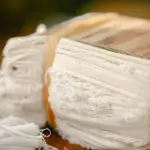Are you aware that 20% of people struggle with threading a needle? Mastering this skill can save you time and frustration, making your sewing and crafting experiences more enjoyable.
In this guide, you'll learn 8 easy steps to thread a needle like a pro. By following these detailed instructions, you'll gain the confidence and precision needed to tackle any sewing project.
From holding the needle properly to securing the thread, each step is designed to help you achieve mastery.
So, gather your supplies and get ready to elevate your needle-threading game!
Key Takeaways
- Choose the right needle for the fabric type and thickness of the thread
- Hold the needle properly for better control and precision
- Dampen the thread with water to prevent fraying and make it more pliable
- Consider double-threading the needle for a secure and durable stitch
Gather Your Supplies
Grab a needle and thread from your sewing kit. When choosing a needle, consider the type of fabric you'll be working with. For lightweight fabrics like silk or chiffon, a fine needle such as a size 9 or 10 is ideal. For medium-weight fabrics like cotton or linen, a size 11 or 12 needle works well. Heavyweight fabrics like denim or upholstery material require larger needles, typically size 14 or 16. The needle should easily pass through the fabric without causing damage.
Next, consider the thickness of the thread. Thicker threads, such as upholstery or topstitching threads, require larger needle eyes to accommodate them. Conversely, finer threads, like embroidery floss or silk thread, require smaller needle eyes to prevent the thread from slipping out. Always match the thread thickness to the needle size for smooth and secure stitching.
Now that you have your needle and thread selected, it's time to move on to the next step in threading your needle like a pro.
Cut the Thread
When cutting the thread, it's important to consider the length you'll need for your specific project. Use sharp scissors to ensure a clean and precise cut that will make threading easier.
Once you've cut the thread, secure it with a knot at the end to prevent unraveling as you work.
Thread Length Matters
Cutting the thread to the appropriate length is crucial for successful needle threading. The right thread length ensures proper tension and prevents excessive tangling or wastage.
When cutting the thread, consider the needle size and the type of stitching you plan to do. For general sewing, a thread length of around 18-24 inches is suitable. Longer threads may lead to increased tangling and decreased tension, while shorter threads may result in frequent re-threading.
However, for detailed embroidery work, shorter thread lengths of 10-12 inches are preferable to maintain better control and minimize wear and fraying.
Use Sharp Scissors
Ensure sharp scissors are used to cut the thread cleanly, avoiding fraying or damage to the fibers.
When using sharp scissors, hold them perpendicular to the thread to create a clean, precise cut. Proper technique involves closing the scissors smoothly and steadily, without applying too much force that could crush the thread. Always use the tips of the scissors for precision.
Additionally, it's essential to maintain scissor care by regularly sharpening them to ensure a clean cut every time. Avoid cutting materials other than thread with your fabric scissors, as this can dull the blades.
Secure With a Knot
To secure the thread after threading the needle, tie a small knot at the end of the thread, ensuring it's tightly secured before cutting off any excess. Use a simple and effective knot-tying technique to ensure the thread remains secure during sewing.
After threading the needle, take the end of the thread and form a loop. Then, wrap the end of the thread around the loop two or three times, creating a small knot close to the end of the thread. Pull the knot tight to ensure it's secure.
Once the knot is firmly in place, use sharp scissors to cut off any excess thread, leaving just a small tail.
This method ensures that the thread remains securely in the needle, allowing you to focus on your needlework without worrying about the thread coming loose.
Hold the Needle Properly
Hold onto the needle with your thumb and index finger, making sure it doesn't wobble. Proper hand positioning is crucial for threading efficiency. Position the needle between your thumb and index finger, allowing for precise control. Your grip should be firm but not too tight, as this can cause hand fatigue. Ensure that your hand is steady and your fingers are positioned close to the eye of the needle for better visibility and control.
When holding the needle, maintain a relaxed posture to prevent hand strain. Avoid gripping the needle too tightly, as this can lead to shaky hands and difficulty in threading. Keep your wrist straight and steady to provide a stable base for your hand movements. This will make it easier to guide the thread through the needle's eye with accuracy.
Properly holding the needle also involves finding a comfortable position for your hand. Experiment with different hand positions to see what works best for you. Some people find it helpful to rest their hand on a flat surface while threading, while others prefer to hold the needle in the air. Find a position that allows you to maintain control and precision while threading the needle.
Wet the Thread
Dampen the thread with water to make it more pliable and easier to thread through the needle's eye. Wetting the thread offers several benefits. Firstly, it helps to prevent the thread from fraying, making it easier to guide through the needle's eye. Additionally, a damp thread is more manageable and less likely to knot, which can save valuable time during your sewing projects.
To ensure you are threading like a pro, here are some needle threading tips:
| Needle Threading Troubleshooting | Sewing Techniques |
|---|---|
| Use a needle threader for small needles | Hold the needle steady |
| Trim the thread end to a point | Use good lighting |
| Try a different needle if the eye is too small | Use a contrasting background |
Insert the Thread Into the Needle
After wetting the thread, you can now proceed to insert it into the needle. This step may seem simple, but it can be quite challenging, especially for those new to sewing. However, with the right techniques, you can master this skill effortlessly.
Follow these steps to insert the thread into the needle like a pro:
- Hold the Needle Properly: Grasp the needle between your thumb and index finger, ensuring a steady grip. This will provide better control and precision when inserting the thread.
- Utilize Advanced Threading Methods: Consider using advanced threading techniques such as using a needle threader or applying a small amount of clear nail polish to the end of the thread to prevent fraying. These methods can make the threading process much easier and more efficient.
- Troubleshooting Tips: If you're facing challenges with threading, try placing a piece of white paper behind the needle to provide a contrasting background, making it easier to see the eye of the needle. Additionally, ensure that the thread is cut cleanly at a 45-degree angle to facilitate smooth insertion into the needle.
Double-Thread the Needle
Ready to take your needle threading skills to the next level?
Double-threading your needle is a game-changer when it comes to stitching efficiency.
Needle Threading Hacks
To ensure a secure and durable stitch, you'll need to thread the needle with a double strand of thread. Here are some needle threading hacks to help you double-thread the needle like a pro:
- Use Threading Tools: Invest in a needle threader or magnifying glass with a built-in needle threader to make the process easier.
- A needle threader with a fine wire loop can help guide the thread through the needle's eye effortlessly.
- A magnifying glass with a needle threader can aid in precision threading, especially for those with visual challenges.
- Both these tools are excellent for beginners and can significantly improve the threading experience.
Threading Needle Quickly
Begin by inserting the double strand of thread into the eye of the needle using a needle threader or magnifying glass with a built-in needle threader for precision. Needle threading tools like needle threaders can greatly assist in quickly threading a needle with a double strand of thread.
To double-thread the needle efficiently, hold the needle steady and insert the wire loop of the needle threader through the needle's eye. Then, carefully place the double strand of thread into the loop and gently pull the needle threader back through the eye. Once the double strand of thread is through the eye, carefully pull it to ensure it's evenly threaded.
These threading needle techniques, when done swiftly and accurately, can save time and frustration, allowing you to focus on your sewing or crafting project.
Test the Thread
Once you have threaded the needle, check if the thread easily glides through the eye of the needle when pulled. Testing the thread is crucial to ensure proper thread tension and to avoid any issues while sewing. Here's how to test the thread like a pro:
- Hold the needle with one hand and gently pull the thread with the other. The thread should smoothly slide through the eye of the needle without any resistance, allowing it to move freely.
- Imagine the thread as a seamless extension of the needle, effortlessly passing through the eye and ready to be used in your sewing project.
- Visualize the thread forming neat and even stitches, contributing to the overall quality of your sewing work.
- Consider the different types of needles and how thread testing may vary based on needle sizes and eye shapes. For instance, larger needles may require slightly more force to pull the thread through, but it should still move without excessive difficulty.
Secure the Thread
Start by passing the threaded needle through the fabric, then pull the thread until only a small tail remains on the surface. To securely fasten the thread, follow these steps to ensure proper tension and avoid any unraveling.
| Steps to Secure the Thread | |
|---|---|
| Step 1: | Hold the tail of the thread and the needle, then make a small stitch on the fabric. |
| Step 2: | Loop the thread around the needle a couple of times to create a small knot. |
| Step 3: | Gently pull the needle through the loop to tighten the knot close to the fabric. |
| Step 4: | Repeat steps 1-3 for added security, especially when working with delicate or slippery fabrics. |
Proper thread tension is crucial for a secure stitch. Adjust the tension based on the thickness of the fabric and the needle size. A smaller needle creates smaller holes, while a larger needle is suitable for heavier fabrics. Mastery of securing the thread ensures that your stitches remain intact, allowing you to sew confidently and professionally.
Frequently Asked Questions
How Do I Choose the Right Type of Needle for Different Types of Fabric?
When choosing the right needle for different fabrics, consider the fabric's weight and weave. Use a smaller needle for lightweight fabrics and a larger needle for heavier fabrics. Match the needle size to the thread for smooth, professional stitching.
Can I Use Dental Floss as a Thread Alternative?
Yes, dental floss can be used as a thread alternative for sewing in a pinch. When using dental floss as a thread alternative, consider the needle size based on the fabric and the dental floss's thickness.
What Can I Do if I Have Trouble Seeing the Eye of the Needle?
Having trouble seeing the eye of the needle? Try a needle magnifier or needle threader for better visibility. Needle threading gadgets or a needle thread lubricant can also make the process easier.
How Do I Prevent the Thread From Tangling While Threading the Needle?
To prevent tangling, select the right needle type for your fabric. Keep the thread end straight and moisten it slightly with saliva. Use a needle threader for better control and twist the thread to secure it.
Are There Any Tips for Threading Very Small or Delicate Needles?
When threading very small or delicate needles for fine needlework or embroidery, use these tips and techniques to make it easier. Hold the needle close to a light source to see the eye clearly and moisten the thread's tip for easier threading.
- The Use of Nonwovens in Construction and Civil Engineering - July 11, 2025
- The Use of Nonwovens in Construction and Civil Engineering - July 11, 2025
- The Use of Nonwovens in Construction and Civil Engineering - July 11, 2025







